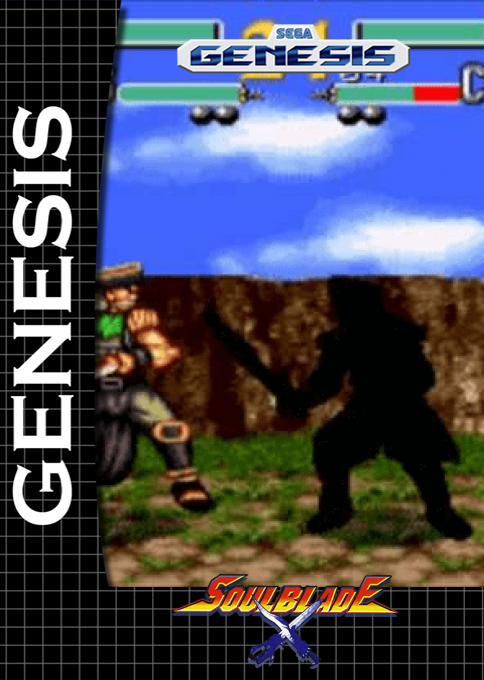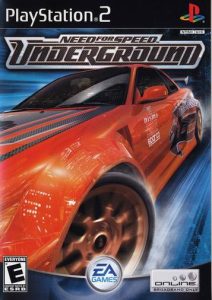Soul Blade
Soul Blade is a fighting game developed by the Namco team Project Soul and published by Namco as the first installment in the Soulcalibur series of 3D fighting games. Introduced at the JAMMA trade show in November 1995,[8] the full arcade game was released in early 1996, while later in December an upgraded and expanded version of the game was ported to the PlayStation. The PlayStation version was renamed Soul Blade in North America, Europe, and Australia.
The plot centers upon the eponymous sword, shrouded in mystery and rumored to offer unlimited power to anyone who can find and wield it; nine warriors embark on a journey to pursue a tenth who is rumored to have the sword, some to claim it and others to destroy it. The game was a commercial and critical success and was followed up with Soulcalibur in July 1998.
Gameplay – Soul Blade

Soul Edge was created prior to the introduction of the so-called 8-Way Run. The characters can sidestep to either side by double-tapping down to move to the foreground or tapping down then up to the background. The jump maneuver (which in Soulcalibur is more like a hop) moves the player higher into the air, even allowing it to pass above the opponent (much like in Tekken).
The game uses an active block system performed by pressing the block button, and a combat system based on the three attack buttons: horizontal attack, vertical attack, and kick.
Character moves retain a feel of Namco’s Tekken series. Each character has one or two slow but unblockable attacks. Each character is also capable of performing one or two “Critical Edge” attacks, consisting of a long series of linked hits, usually ending in a strong high attack.
These moves require the input of a special combination of two parts: they are activated by pressing all three attack buttons together, and if it connects, the player has the chance of extending the combo with a character-specific sequence, which must be input during the attack. This attack depletes one-third of the Weapon Gauge when used.
The Weapon Gauge is a life bar for the character’s equipped weapon. Each time the player blocks an attack, the bar depletes. If the bar is totally emptied, the weapon is lost and the character is forced to fight unarmed.[9]
The unarmed move-lists are the same for every character. Another feature that was removed from Soulcalibur‘s engine is a rock paper scissors situation when two character strike at the same time, locking their weapons; those who press the correct button have the advantage.
Soul Edge uses an optional offensive block maneuver called the “Guard Impact” that allows players to intercept incoming attacks and push them back, resulting in a momentary opportunity for a free counterattack.
Opponents, however, are also able to return a Guard Impact after receiving a Guard Impact, allowing for stalemate clashes until one opponent missed the subsequent timing. This gameplay feature is expanded in future Soul series games.
The game uses the ring out system, which is a forcible maneuver that ejects the opponent from the arena and gains an automatic victory for the round. To achieve a ring out, a character must be knocked outside the ring by an enemy (the player cannot accidentally or deliberately get a ring out by hopping out of the ring).
The only exception to this rule is Cervantes and Inferno (known in this game as SoulEdge), who can get a ring out by themselves upon performing a certain special attack, as long as they are near the edge of the arena.
Development and release – Soul Blade
Soul Edge was developed as an experiment by Namco to explore the possibilities of a weapon-based fighting game.[12][13] It was the first motion capture based video game created by using passive optical system markers.[14]
Soul Edge was initially released in arcades in 1995. A Gamest Mook series guide book (GMC-30) was published by Shinseisha on April 30, 1996.[15]
A couple of months later, Namco released a fixed version, labeled Soul Edge Ver. II.[16] Hwang (initially a palette swap of Mitsurugi for the Korean version of the game) was introduced to Japanese players with a new move list, Cervantes became playable, Guard Impacts and Air Combos were implemented, all the characters received upgraded move lists, and new stages were added.[17] The overseas PlayStation version was renamed Soul Blade to avoid potential complications due to EDGE Games‘ earlier “EDGE” trademark.
PlayStation – Soul Blade
The PlayStation game received very positive reviews. It holds aggregated scores of 91% on GameRankings[22] and 89/100 on Metacritic,[23] including high ratings by IGN (“extremely fun, and has just enough new elements to make it worth playing multiple times”),[31] and GameSpot (“a great fighting game with its share of flaws”).[40]
Next Generation praised it for “filling in all the blanks with great gameplay, superb characters, unique graphics, and combines them into one solid package.”[32] They later commended the PlayStation port for retaining all the characters, levels, graphics, and gameplay from the arcade version.[33] GameFan called it “without a doubt the most stunning graphical fighting feast ever to grace any console.”[41]
The four reviewers of Electronic Gaming Monthly particularly applauded the full motion video intro and the new story mode.[42] They awarded it “Best Intro” in their 1998 Video Game Buyer’s Guide.[43] A reviewer for GamePro stated: “Bow down to the new king of fighters, and the first gotta-play-it game of the year.”[44]
In 1997, PSM named Soul Edge as the fourth top game on the PlayStation,[45] and Electronic Gaming Monthly listed the PlayStation version as a runner-up for “Fighting Game of the Year” (behind Street Fighter Collection) and “Best Music” (behind PaRappa the Rapper).[46]
PSU listed this game as the sixth “PSone classic” most deserving to be remade for the PlayStation 3 in 2011.[47] That same year, Complex ranked Soul Edge as the 19th best fighting game of all time.[48]
The PlayStation version’s opening sequence won the SIGGRAPH ’97 award for the best game video of 1996.[49] It was also included on the list of the ten all-time best game cinematics by Cheat Code Central in 2012.[50
 (En) (Unl)-1024x656.png)
Siegfried’s Theme
Taki’s Theme
Heishiro’s Theme
Rock’s Theme
Sophita’s Theme











